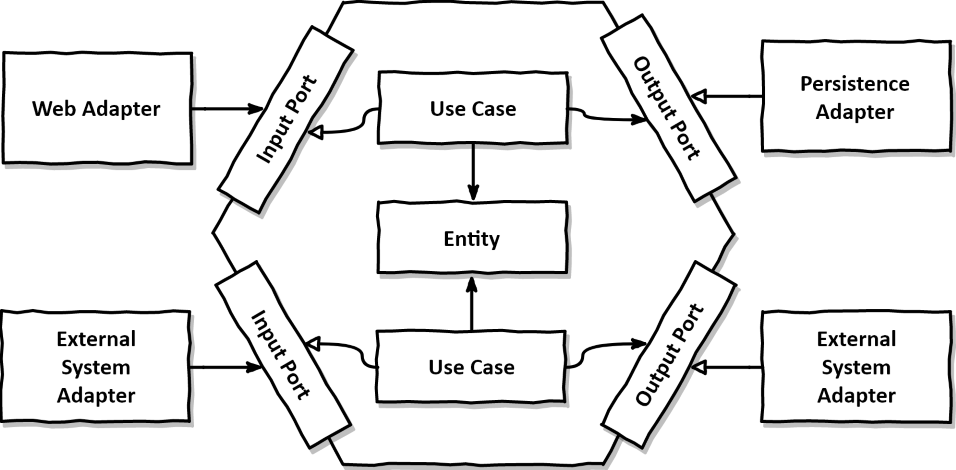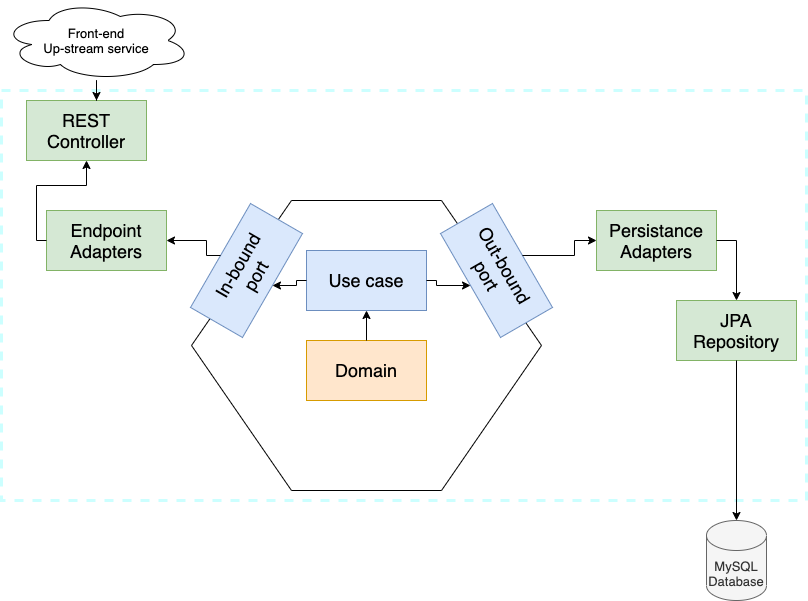This project is to expose my interpretation of the hexagonal architecture, under spring-boot framework.
The diagram of the hexagonal architecture relies on the following:
I have tried to take a diagram that I have seen common on different articles, even though I saw port/adapter to be swap.
This architecture follows the clean architecture from Uncle bob:
https://blog.cleancoder.com/uncle-bob/2012/08/13/the-clean-architecture.html
This project is following this diagram on spring-boot framework.
On this I was doing the following approach diagram:
Where we have as part of the application is:
- REST implementation
- Database connection
The colors meant to be:
- Orange: this is the domain model of our application, that is located on
com.example.service.user.domain - Blue: this is the application itself, where we have the logic and the ports (to apply this logic from and to). The package is:
com.example.service.user.application - Green: this is the package
com.example.service.user.adapter, where are the implementation of the ports. It was decided to keep the repositories and the controllers, even though this could be moved to theinfrastructurepackage.
What was not played out on this diagram was the package:
com.example.service.user.infrastructure
This package is cross, so it was not having a flow on the diagram, but impacts to be defined shared components.
The domain model is a simple one, for user management.
This diagram it is just a simple information for eventual User domain. We can see the following domain model diagram:
where the colors here represents:
- Orange: entity or root aggregate of our domain
- Blue: value objects
This domain has a functions class, where it is a bunch of functions to access to User entity information.
It was implemented the arch rules from arch unit library.
The tests are located on:
com.example.service.user.architecture.*
The tests develop were doing unit tests for each class of the project.
Do integration test on the controller, which is our application entry point.
In order to have not coupling with the spring boot reactive approach, it was defined two wrappers:
com.example.service.user.infrastructure.reactive.CollectionReactive: wrapper of theFluxobject from reactive spring (reactor) approach.com.example.service.user.infrastructure.reactive.UnitReactive: wrapper of theMonoobject from reactive spring (reactor) approach.
These objects are used in the application level, to control the access to the reactive objects.
There is a problem when requiring transaction, where @Transactional cannot be used, as Flux/Mono are not being used. To have transactions we can use:
org.springframework.transaction.reactive.TransactionalOperator
We can see its use on the test:
com.example.service.user.adapter.entrypoint.api.UserControllerIntegrationTest
com.example.service.user.adapter.persistence.UserRepositoryTest


